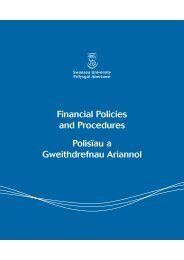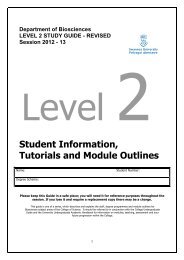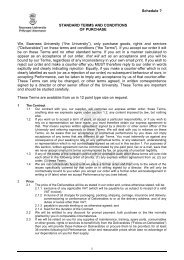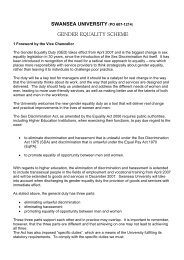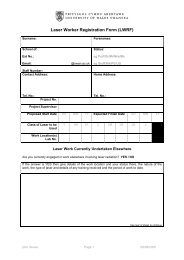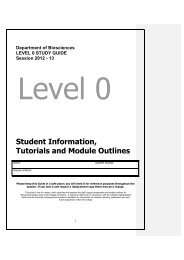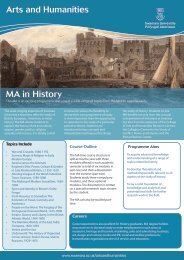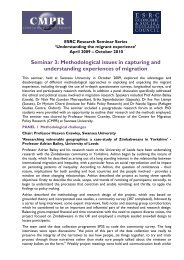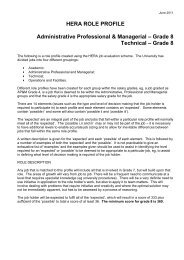ABSENCE MANAGEMENT POLICY - Swansea University
ABSENCE MANAGEMENT POLICY - Swansea University
ABSENCE MANAGEMENT POLICY - Swansea University
You also want an ePaper? Increase the reach of your titles
YUMPU automatically turns print PDFs into web optimized ePapers that Google loves.
M3004<br />
PRIFYSGOL ABERTAWE<br />
SWANSEA UNIVERSITY<br />
<strong>ABSENCE</strong> <strong>MANAGEMENT</strong><br />
<strong>POLICY</strong><br />
October 2007<br />
1
CONTENTS<br />
1. Introduction<br />
3<br />
Equal Opportunities Statement<br />
2. Roles and Responsibilities 4-5<br />
3. Notification of Sickness Absence 5-6<br />
4. Annual Leave 7<br />
5. Sick Pay 8<br />
6. Management of Short-Term/Frequent Sickness Absence 9-10<br />
7. Management of Long-Term Sickness Absence 11<br />
8. Termination of Employment – Long Term Absence 12<br />
9. Ill-Health Retirement 13<br />
10. Absence Statistics 14<br />
Appendices<br />
2
1. Introduction<br />
<strong>Swansea</strong> <strong>University</strong> has a duty of care to provide a safe and effective<br />
environment for Human Resources. Human Resources are the main asset of<br />
the <strong>University</strong> and are key to the achievement of the <strong>University</strong>’s Strategic<br />
Plan.<br />
Absence is both costly and disruptive to the <strong>University</strong>, therefore the aim of<br />
this policy is to ensure that procedures are in place to effectively monitor and<br />
manage absence for the benefit of both individuals and the <strong>University</strong>. This<br />
policy is designed to ensure there is a consistent and supportive approach to<br />
managing both short and long term absence.<br />
This policy covers all members of staff.<br />
Throughout this document the term “manager” is used. This is more<br />
appropriate in some departments than others. This term refers to an<br />
individual’s immediate supervisor in a line management relationship. The<br />
structure of line management responsibility should be devolved by the Head<br />
of School/Department.<br />
Equal Opportunities Statement<br />
<strong>Swansea</strong> <strong>University</strong> is committed to ensuring that all individuals are given<br />
equal opportunities within the <strong>University</strong>. The <strong>University</strong> has a duty to<br />
eliminate unlawful discrimination throughout the organisation and this policy<br />
will address the equality of opportunity for all individuals in accordance with all<br />
employment legislation, including the Disability Discrimination Act 1995.<br />
3
2. Roles and Responsibilities<br />
In order to ensure fair and consistent treatment it is essential that all<br />
individuals carry out their roles and responsibilities in managing absence.<br />
2.1 Role of the Employee<br />
• To notify the appropriate person in the School/Department on their first<br />
day of absence, or as soon as practicable, in accordance with the<br />
correct procedures for notification of sickness absence.<br />
• To maintain regular contact with their manager, as appropriate, during<br />
their period of absence.<br />
• To obtain appropriate medical certification if the absence exceeds<br />
seven consecutive calendar days.<br />
• To seek the appropriate advice and treatment to facilitate their<br />
recovery. Employees who engage in activities which may impede their<br />
recovery and delay their return to work could be subject to disciplinary<br />
action, and/or have their entitlement to Occupational Sick Pay<br />
withdrawn.<br />
• To inform their manager when they expect to be fit to return to work<br />
and be certified fit to do so.<br />
• To attend absence meetings or medicals when requested.<br />
• To attend a return to work review following each period of absence.<br />
2.2 Role of the Head of School/Department<br />
• To ensure that the policy is applied in a fair and consistent manner.<br />
• To ensure that notification procedures are followed with accuracy and<br />
timeliness.<br />
• To maintain communication with absent staff as appropriate.<br />
• To conduct return to work reviews.<br />
• To monitor sickness absence, highlighting patterns of frequent<br />
absence, and/or areas of concern.<br />
• To ensure staff members within the School/Department who are<br />
involved in managing absence are aware of the policy and procedures<br />
and are trained accordingly.<br />
• To seek advice and support from the Human Resources Department,<br />
as required.<br />
2.3 Role of the Human Resources Department<br />
• To provide advice and support to Schools/Departments for managing<br />
both short and long term absence.<br />
• To liaise closely with managers to ensure the policy and its procedures<br />
are fairly applied.<br />
• To refer individuals to the Occupational Health Department, as<br />
appropriate.<br />
• To provide training sessions as requested.<br />
• To monitor and review the Absence Management Policy to ensure best<br />
practice.<br />
• To liaise with external agencies, as appropriate.<br />
4
2.4 Role of the Occupational Health Department<br />
• To provide a confidential support service to employees.<br />
• To provide medical advice to the Human Resources Department<br />
regarding employee fitness in relation to their duties/attendance at<br />
work and, where appropriate, offer guidance on alternative duties and<br />
adjustments to the workplace.<br />
2.5 Role of the Staff Counselling Service<br />
• To provide a confidential counselling service to members of staff.<br />
3. Notification of sickness absence<br />
It is the responsibility of the employee to inform the nominated representative<br />
in their School/Department by telephone, as early as possible on the first day<br />
of absence. They should indicate the reason for the absence and where<br />
possible give an indication of the anticipated duration of the absence.<br />
In exceptional cases a telephone call from a friend or relative will be accepted.<br />
Throughout the period of absence, employees are required to keep their<br />
manager (or nominated representative) informed of their progress and when<br />
they are expecting to be able to return to work. The frequency of this contact<br />
can be agreed, dependant on the reason for the absence and the expected<br />
timescale for recovery.<br />
Failure to provide the necessary certification could lead to sick pay being<br />
suspended until the documentation is received. In the case of continued<br />
failure to provide certification, disciplinary action may be taken.<br />
3.1 Definition of the “first day” of absence<br />
The “first day” of absence is the first complete day of absence. Saturdays,<br />
Sundays and Bank Holidays should be included as absence days. Also, for<br />
those who work part-time or shifts, days off will be counted if absence covers<br />
these periods. This complies with the Statutory Sick Pay rules.<br />
If an employee becomes ill whilst at work and is subsequently sent home, or<br />
absents themselves, and is absent from work on the following working day,<br />
they must follow the notification procedures as above. If they have not done<br />
any work on the day they were sent home/absented themselves, then that day<br />
would be deemed as the first day of sickness.<br />
3.2 For periods of sickness between 1-7 calendar days<br />
Staff must complete a Self Certificate Form (Appendix 2), as required by both<br />
the <strong>University</strong>’s Occupational Sick Pay Scheme and Statutory Sick Pay<br />
procedures. This form will be completed when the individual has returned to<br />
work and has had their Return to Work Review The form is then signed by<br />
the Line Manager (or nominated representative) and forwarded to the Human<br />
Resources Department.<br />
5
3.3 For periods of sickness lasting more than 7 calendar days<br />
Staff who are absent due to sickness for more than seven consecutive<br />
calendar days must obtain a doctor’s certificate. This certificate should be<br />
sent to the designated individual in the School/Department on the seventh day<br />
of absence, or as soon as practicable.<br />
If the absence continues and further medical certificates are required, then<br />
where possible these should be received by the School/Department before<br />
the previous certificate expires. In cases where this is not possible, i.e. for<br />
reasons outside the individual’s control, the individual must inform their line<br />
manager prior to the expiry of the current certificate.<br />
3.4 Late Notification<br />
If individuals fail to notify the <strong>University</strong> of their sickness absence, or are<br />
unreasonably late in informing their School/Department, payment of<br />
Occupational/Statutory Sick Pay may be withheld.<br />
If individuals have difficulty in complying with the notification procedure (e.g.,<br />
they do not have access to a telephone or live alone), then individuals need to<br />
consider alternative arrangements in advance of any likely occurrences of<br />
absence.<br />
3.4 Hospital Treatment<br />
In cases where an employee is a hospital in-patient, the hospital will provide<br />
the relevant certification.<br />
3.5 Returning to Work<br />
Employees are encouraged to give as much notice of their return to work as is<br />
practically possible. On returning to work employees must report to their<br />
manager for their return to work review (Please refer to the Return to Work<br />
Review Guidance notes – Appendix 1). During this review the return to work<br />
form (Appendix 2) will be completed and signed by both parties. This form will<br />
then be sent to the Human Resources Department, to be held on file.<br />
If employees have provided medical certification to cover their period of<br />
absence they will need to complete Part B on the back of the medical<br />
certificate. If this is not completed then a return to work certificate will be<br />
required to confirm that the employee is fit to return to work.<br />
If employees have been absent for an extended period of time, they may be<br />
required to attend Occupational Health prior to their return to work.<br />
Occupational Health can then advise the employee/school/department of any<br />
ongoing health implications, and/or possible adjustments to the employee’s<br />
work station, shift pattern or duties.<br />
6
4. Annual Leave<br />
In cases where an employee falls sick during a period of annual leave, if the<br />
correct certification is provided, the employee will be recorded as sick for the<br />
period of the certification. The annual leave may be taken at another date<br />
before the end of the current leave year, subject to the usual approval<br />
mechanism.<br />
If an employee who is on sick leave takes a holiday, then they should inform<br />
their manager in advance and seek advice from their Doctor to ensure that<br />
this is appropriate in their current state of health.<br />
If an employee returns to work following a period of long term sickness, they<br />
are entitled to take any outstanding leave from the current leave year on their<br />
return, subject to the usual approval mechanism. As with the Annual Leave<br />
policy, there may be circumstances whereby employees are unable to take all<br />
their outstanding leave in the current year. Therefore, they may request<br />
approval to carry forward 5 days to the next leave year. If employees return to<br />
work after the previous leave year and have an outstanding balance they may<br />
request approval to carry over 5 days to the current leave year.<br />
Examples<br />
Employee 1<br />
• Absent from work 01/04/05 to 31/07/05.<br />
• No leave taken before their absence.<br />
• On their return (01/08/05), they have a full year’s leave entitlement to take<br />
before 31/12/05.<br />
• Possibility of carrying 5 days into following leave year (2006).<br />
Employee 2<br />
• Absent from work from 01/08/05 to 31/03/06.<br />
• From 2005 they have 15 days of annual leave outstanding and full<br />
entitlement for 2006.<br />
• They have an option to carry over 5 days from 2005.<br />
All requests for taking leave must be accordance with the agreed approval<br />
procedures within the School/Department.<br />
7
5. Sick Pay<br />
For full detail on the eligibility and entitlements to Statutory and Occupational<br />
Sick Pay, please refer to the following documents:<br />
Sickness Pay Scheme (J8131)<br />
http://www.swan.ac.uk/media/Media,4869,en.pdf<br />
Statutory Sick Pay (L8361)<br />
http://www.swan.ac.uk/media/Media,5114,en.pdf<br />
8
6. Management of Short-Term/Frequent Sickness Absence<br />
Short-term/frequent periods of absence can be very disruptive to the<br />
<strong>University</strong> and place an added burden upon colleagues to cover these<br />
absences. These are absences that generally cover minor ailments and in<br />
most cases are unconnected to previous absences.<br />
The following are the stages in the process of managing short-term absence:<br />
Level 1 – Return to Work Review<br />
These will take place following every period of sickness absence. The<br />
purpose of the review is to monitor absence, give support where required and<br />
update individuals on any workplace matters.<br />
Level 2 – Informal Stage<br />
Managers will be reviewing absence records on a regular basis. In cases<br />
where there are:<br />
• Three or more separate periods of sickness absence (self-certified<br />
and/or supported by medical certificate) within a six month rolling<br />
cycle.<br />
• Four periods of self-certificated absence within one absence year<br />
where none of these periods has been supported by a medical<br />
certificate.<br />
In both cases a period may be one day or a number of days.<br />
Or<br />
• Where there is a clear pattern of persistent absence, e.g. Monday<br />
mornings.<br />
The manager will hold an informal absence meeting with the employee to<br />
discuss the reasons for the absences. During this meeting, the employee will<br />
be expected to provide a full explanation on the causes of the absences. The<br />
outcome will be confirmed in writing, and employees will be reminded that<br />
their absence record will continue to be monitored, that an improvement in<br />
attendance is expected, and that further periods of sickness absence could<br />
lead to more formal action being taken.<br />
Where employees are unable to attend an absence meeting they should<br />
inform their manager in order that another suitable date can be arranged.<br />
In the event that an employee fails to attend work on the day after or shortly<br />
after a meeting at which an issue of concern has been discussed with them, a<br />
self certificate or doctor’s certificate may not be accepted as a reason for<br />
refusing to attend any further meeting to discuss the matter.<br />
If the employee indicates or alleges that they are not well enough to attend a<br />
meeting and sends in the appropriate certification that this is the case, this<br />
may not be considered full evidence to the <strong>University</strong>. Further evidence may<br />
be requested from relevant medical practitioner.<br />
9
Level 3 – Formal Stage<br />
If, following the informal meeting, further periods of sickness absence occur<br />
then the manager will again meet with the individual to clarify the reasons for<br />
their absences and, dependent on the circumstances of the particular case,<br />
may proceed to take formal action.<br />
Formal Stage<br />
This meeting will be held with the manager and a representative from the<br />
Human Resources Department. Employees will be advised of the meeting in<br />
writing, be given at least five working days notice of the meeting, plus the<br />
right to be accompanied by a Trade Union Representative or work colleague.<br />
The meeting will follow on from the informal stage. During the meeting the<br />
sickness record will be confirmed and the employee will be given full<br />
opportunity to explain the reasons for their absences. If applicable, possible<br />
support initiatives or adjustments should be discussed and, if further advice is<br />
required then employees should be referred to Occupational Health.<br />
If it has been established that there are related medical reasons for the<br />
employee’s absences, their absence will be managed under the guidelines for<br />
managing long-term absence. This will be assessed on an individual basis.<br />
At this meeting, employees should be reminded that an improvement in<br />
absence levels is expected within an agreed timescale and failure to improve<br />
may lead to action being taken under the relevant disciplinary and dismissals<br />
procedure.<br />
At any point during this procedure it may be necessary to refer individuals to<br />
the Occupational Health Department to gain medical advice.<br />
In cases where an individual continually fails to attend such meetings, their<br />
absence record will be considered based on the information available at that<br />
time, and appropriate action, including possible disciplinary action taken.<br />
10
7. Management of Long-Term Sickness Absence<br />
Long-term absence can be defined as periods of sickness absence that are<br />
continuous for more than six weeks or frequent absences of a related manner.<br />
Long-term sickness absence should be managed in a sympathetic and<br />
flexible manner, taking into consideration the individual circumstances.<br />
Once an employee has been absent for more than six weeks, or where<br />
certification indicates an absence of this duration, they may be required to<br />
attend a meeting with their manager and a member of the Human Resources<br />
Department and/or attend a medical appointment at the Occupational Health<br />
Department. The decision as to whether to invite the employee to an<br />
interview or appointment will be dependent on the nature of their absence.<br />
The invitation to attend all meetings will be in writing from the Human<br />
Resources Department and individuals will have the right to be accompanied<br />
by a Trade Union Representative or colleague. If circumstances are such that<br />
the employee cannot attend the <strong>University</strong> for the meeting/appointment then<br />
arrangements can be made for home visits.<br />
In cases where an individual refuses or continually fails to attend such<br />
meetings, with no good reason, their absence record will be considered based<br />
on the information available at that time. Appropriate action, including possible<br />
disciplinary action/termination of employment may be taken.<br />
Purpose of a Long-Term Sickness Absence Meeting<br />
This meeting will be held with the manager and a member of the Human<br />
Resources Department. The purpose of the meeting will be:<br />
• To understand the reason for the absence.<br />
• Establish if there is a known time scale for their return to work.<br />
• Understand if any measures/assistance can be taken to help facilitate a<br />
return to work.<br />
• To ascertain if the employee should be referred to Occupational Health<br />
for further advice and support on their medical condition.<br />
• To decide on an appropriate timescale for review meetings.<br />
The outcome of these meetings will be confirmed in writing by the Human<br />
Resources Department.<br />
Purpose of attending Occupational Health<br />
• To gain more medical information on the reason for absence.<br />
• To gain advice on readjustment/redeployment matters as appropriate.<br />
• To seek external medical advice, as necessary, with the consent of the<br />
individual.<br />
During long-term absence it is essential that the employee maintains regular<br />
contact with their manager on their progress and also provide the required<br />
documentation to cover their absence on a timely basis.<br />
If employees are absent from work due to stress, on receipt of the notification<br />
a Human Resources Officer will then liaise with the Occupational Health<br />
Department to arrange an appointment to see the employee as soon as<br />
possible if the absence is likely to exceed two weeks, in accordance with the<br />
Policy on Occupational Stress.<br />
11
8. Termination of Employment – Long Term Absence<br />
In cases where it appears that:<br />
• A return to work is unlikely in the foreseeable future based on medical<br />
evidence.<br />
• A return to work is not impending despite having medical evidence<br />
supporting a return.<br />
• No alternative employment can be found.<br />
then the termination of the employee’s contract will need to be considered.<br />
Before any decision on termination is taken the following steps must be taken:<br />
• Consider the length of absence and the outcome of any informal/formal<br />
reviews held with the employee.<br />
• Gain up-to-date medical information from Occupational Health/GP.<br />
• Explore all options, where practicable for:<br />
• Adjustment to duties or changes in working practices.<br />
• Redeployment within the School/Department or across the<br />
<strong>University</strong>.<br />
• A phased rehabilitation back into the workplace, which could<br />
include lighter duties or a reduction in contracted hours for a<br />
period of time.<br />
• Consider the option to pursue ill-health retirement.<br />
If these steps have been followed and there is still no evidence that a return to<br />
work will take place in the foreseeable future, it may be appropriate to<br />
terminate employment.<br />
Procedure<br />
A meeting will be held with the individual in the presence of the Head of<br />
School/Department and a representative from the Human Resources<br />
Department. The individual will have the right to be accompanied by a Trade<br />
Union Representative or colleague and they will be given reasonable notice of<br />
the meeting.<br />
If, following the meeting it is agreed that the decision is to terminate<br />
employment this will be done on grounds of ill-health (incapacity). Individuals<br />
will be informed that they would be welcome to apply for any future positions<br />
within the <strong>University</strong>, should their health improve. The outcome of the<br />
meeting will be confirmed in writing.<br />
If the individual does not agree with the decision to terminate their<br />
employment on grounds of ill-health, they will be informed of the appropriate<br />
procedure to follow, which will include a mechanism for appeal. For academic<br />
staff the procedure in the Charter and Statutes will apply.<br />
The relevant notice of termination, or payment in lieu of notice, will be applied.<br />
Payment of notice can run concurrently with sick pay entitlement.<br />
12
9. Ill Health Retirement<br />
Prior to this, it is normal practice for the employee to have undergone a series<br />
of reviews with their Manager, a member of the Human Resources<br />
Department and Occupational Health. The purpose of these reviews would<br />
be to explore any possible re-adjustments to normal duties to facilitate a<br />
return to work, or alternatively, look at redeployment opportunities to a more<br />
suitable role, bearing in mind the individual’s state of health. Should these<br />
options not prove feasible, the employee may pursue an application for illhealth<br />
retirement.<br />
The <strong>University</strong> will not reemploy any member of staff who has been<br />
terminated on the grounds of ill health (this refers to paid employment and<br />
does not preclude honorary appointments) and are in receipt of an ill-health<br />
retirement pension.<br />
13
10. Absence Statistics<br />
The absence statistics are reported to the Universities Human Resources<br />
Committee on an annual basis. The report includes the number of days lost<br />
due to sickness absence, their percentage values, the total number of<br />
absences and the Bradford Score. These figures (based on a given period)<br />
are broken down by School and Department and include the previous year’s<br />
figures for comparison.<br />
The Bradford Factor<br />
This is an absence management tool that can highlight the effect that absence<br />
has within a School/Department. Frequent, short spells of absence can be<br />
more disruptive to the running of a department than longer periods of<br />
absence, that in some circumstances can be planned for.<br />
The Bradford factor uses a formula for measuring an employee’s irregularity<br />
of absence. It is calculated as follows:<br />
S x S x D = Bradford points score<br />
Where S is the number of periods of absence in the last year and D is the<br />
number of days absence in the last year.<br />
For example:<br />
• 1 absence of 6 days is 6 points, (1 x 1 x 6)<br />
• 6 absences of 2 days each is 432 (6 x 6 x 12)<br />
• 12 absences of 1 day each is 1728 (12 x 12 x 12)<br />
14
Appendix 1<br />
Return to Work Reviews – Guidance<br />
Research has shown that return to work reviews are the most effective way of<br />
managing short term absence. They should take place following each period<br />
of absence, regardless of the length of the absence, ideally within the<br />
employee’s first day of return to work. Line managers should conduct the<br />
review. Where individuals request an alternative person to carry out the<br />
review, for reasons such as poor relations or gender issues, then this should<br />
be mutually agreed.<br />
Purpose<br />
• To welcome the employee back to work.<br />
• To ensure the employee is fit to return to work.<br />
• To identify the cause of absence.<br />
• To agree a way forward, if relevant.<br />
• To up-date the employee on what’s been happening in the workplace.<br />
• Be mindful that this is an informal meeting and not a disciplinary<br />
hearing, the purpose is to establish the facts.<br />
Preparation<br />
• Ensure that you have a suitable location to hold the review. It should<br />
be held in a suitable environment, i.e. a private location and not in the<br />
middle of an open-plan office.<br />
• Gather information on the employee’s current period of absence and<br />
also previous absences.<br />
• Be prepared to discuss patterns or trends of absence, if relevant.<br />
• Approach the meeting with an open mind.<br />
Discussion<br />
The nature of the discussion will vary according to the frequency, length or<br />
nature of the absence, but some of the following points may be relevant:<br />
• Welcome the employee back.<br />
• Be positive, highlight that they have been missed.<br />
• Explain purpose of the meeting is to establish why they have been<br />
absent from work.<br />
• Try and determine the cause of absence, be sensitive and calm if<br />
personal problems or stress are discussed.<br />
• Listen to the employee, give them chance to explain.<br />
• Respect their privacy if they do not wish to discuss the reasons for<br />
absence. If this does happen then you can offer them the option to<br />
speak to somebody else. If not then you should highlight that if you<br />
don’t know the problem you are unable to help and their absence will<br />
continue to be monitored.<br />
• If the absence is work-related, what can be done to help, i.e.<br />
adjustments to work hours, work place or duties.<br />
• Establish of the employee is undergoing any treatment, will time off be<br />
required for medical appointments.<br />
15
• Are there any other factors contributing to the absence.<br />
• Place current absence in the context of previous absences.<br />
• Explain the impact of their absence on the colleagues within the<br />
School/Department.<br />
• Explain that their absence will continue to be monitored in line with the<br />
procedure in the Absence Management Policy.<br />
• Agree the next steps, such as a follow-up review, referral to<br />
Occupational Health, attend a training course.<br />
Recording<br />
• Ensure that the correct certification has been provided.<br />
• Complete the return to work form, ensuring that both parties sign to<br />
confirm their agreement in what is recorded.<br />
• Send the appropriate medical certification to Salaries and Wages.<br />
• Send the return to work review form to Human Resources.<br />
16
Appendix 2<br />
<strong>Swansea</strong> <strong>University</strong><br />
Self Certification Form<br />
Full name:<br />
………………………………… Employee No: ……………………………..<br />
Position: ………………………………… Nat Ins No: ……………………………..<br />
School/Department: ………………………………………………………………………...<br />
First full day of absence: …………………… Last day of absence: …………………….<br />
Reason for absence: …………………………………………………………………………<br />
Was the illness due to an injury at work:<br />
If absence is over 7 days, have medical certificates been received:<br />
Return to Work Review<br />
Is there any possibility of a recurrence?<br />
Is further medical treatment required?<br />
If yes, please give details<br />
Yes/No<br />
Yes/No<br />
Yes/No<br />
Yes/No<br />
……………………………………………………………………………………………….<br />
Are there any problems (i.e. work station/place, hours of work, duties) which are<br />
connected to the absence?<br />
Yes/No<br />
If yes, what are they and can any reasonable measures be taken to prevent<br />
recurrence?<br />
…………………………………………………………………………………………………<br />
Are there any measures of support that can be offered?<br />
If yes, please give details<br />
Yes/No<br />
………………………………………………………………………………..<br />
Any further action to be taken (please tick box)<br />
No further action required Refer to Human Resources Department<br />
Hold a review meeting<br />
Request an appointment with Occupational Health (go through Human<br />
Resources Department)<br />
Any further comments:<br />
…………………………………………………………………………………………………..<br />
Line Manager’s Signature: ………………………… Date: ……………..<br />
I declare that I have not worked during the above period of sickness and the<br />
information given is factually correct. I understand that any false information<br />
given may result in disciplinary action.<br />
Employees Signature: ………………………………………………<br />
Date: ……………<br />
17




